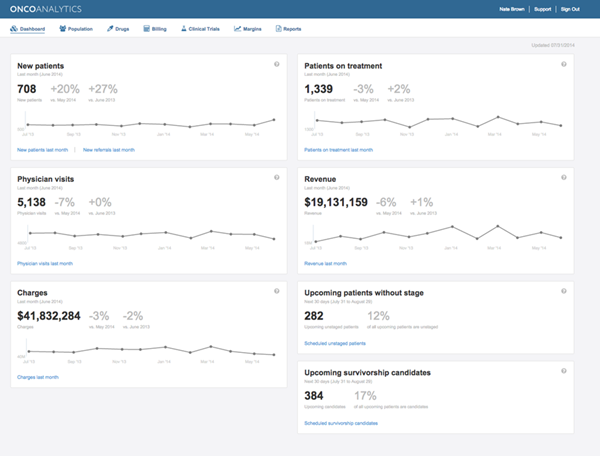AWS News Blog
Flatiron Health – Using AWS to Help Improve Cancer Treatment
Flatiron Health is a hot startup with a great idea – providing cancer patients, physicians, researchers, and drug firms with a solution that organizes global oncology information. Currently more than 230 cancer clinics and about 2,200 clinicians across the United States use their products and services, which support the treatment of approximately one in five U.S. cancer patients. I asked Alex to tell us about Flatiron’s decision to leverage AWS’s platform. In the guest post below, Alex Lo (Engineering Manager of Developer Infrastructure) tells us how they have put AWS to use!
— Jeff;
Flatiron Health began after our founders witnessed family members and friends battle cancer. They were really frustrated by the inefficiencies in accessing and benefiting from all the diverse and siloed oncology data in fragmented medical record systems. Their vision was to build a disruptive software platform that connects cancer centers across the country, with the goal of supporting deeper insights and understanding to transform how cancer care is delivered.
Time to Market
We’re a startup trying to get our solutions like our OncologyCloud software suite to market as quickly as possible, and our team was unable to iterate and innovate as quickly and as reproducibly as we wanted them to due to a lack of mature automation tools and APIs. We want technology to work for us so we can solve business problems, instead of spending time dealing with computers.
I joined Flatiron in 2015, and fortunately by that time AWS had implemented the healthcare industry compliance standards and processes that we needed. This made us confident that our efforts would be successful. By mid-2015 we began an AWS adoption project. We felt AWS would be the best platform for future growth because of its best-in-class features, rich ecosystem, and excellent HIPAA-eligible features that include encryption, fine-grained security, and auditability. It lets us deliver a unique solution and quickly iterate on our products.
AWS Usage
We use a range of AWS services. Amazon EC2 has advanced features that give us access to virtual machine system logs from the administrative console. Amazon S3 provides us infinitely scaling durable storage, and the encryption features provided with AWS make it straightforward for us to store Protected Health Information (PHI) in S3. We’re running in an Amazon VPC, and use Amazon VPN connections to other networks for secure connectivity. We’re also using AWS IAM, which is wonderful in our environment. It gives us fine-grained security controls so we can enable our engineers to create resources without being full administrators. We use it lot and are experimenting with some of the more advanced features, like the AWS Security Token Service and EC2 Roles. We’re also using auditing and security tools, including AWS Trusted Advisor, AWS CloudTrail, AWS Config, and Amazon CloudWatch.
An additional benefit of AWS is the expertise that we get with the platform. AWS gives really good advice on how to build HIPAA-compliant applications, with account reps specializing in life sciences and Solutions Architects with health tech backgrounds. Plus, AWS has a developer ecosystem that is more mature than what other cloud providers offer. For example, Ansible has an out-of-the-box EC2 inventory module that helps us manage our fleet. We also use both the AWS Command Line Interface and Boto—the AWS SDK for Python—to automate other routine tasks. This automation would be more difficult on other cloud providers.
Almost There
We’re nearing the end of our first consolidation project on AWS. There are a lot of variables and planning involved in moving into a cloud platform and it’s taken us about 10 months, but we expect the migration to be completed by April 2016. Our development teams have been benefitting from the AWS environment for months now, and it’s exciting to see them move faster. We’re looking to leverage AWS in more ways going forward, possibly moving some dedicated hosting assets into the elastic cloud.
To us, the benefits of using AWS are clear. AWS, with its support team, compliance team, tools, ecosystem, and continued feature growth is helping us iterate faster to solve problems that matter in improving cancer care.
Learning More
Read an AWS whitepaper on architecting for HIPAA security and compliance on AWS.
Read a two-part deep-dive article by an AWS solutions architect who worked closely with the Flatiron Engineering team. Part 1 is here and Part 2 is here.
— Alex Lo, Engineering Manager of Developer Infrastructure, Flatiron Health
PS – We are looking for great developers interested in making a difference in the fight against cancer. If you’re interested, get in touch with us.
